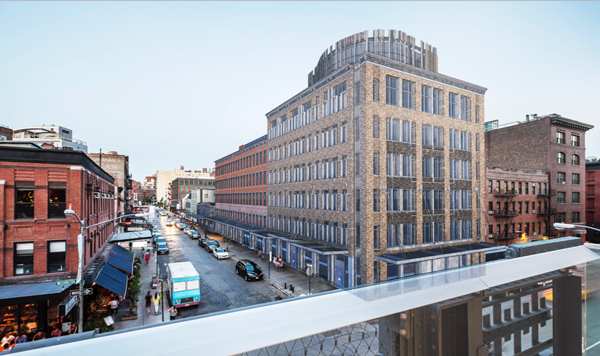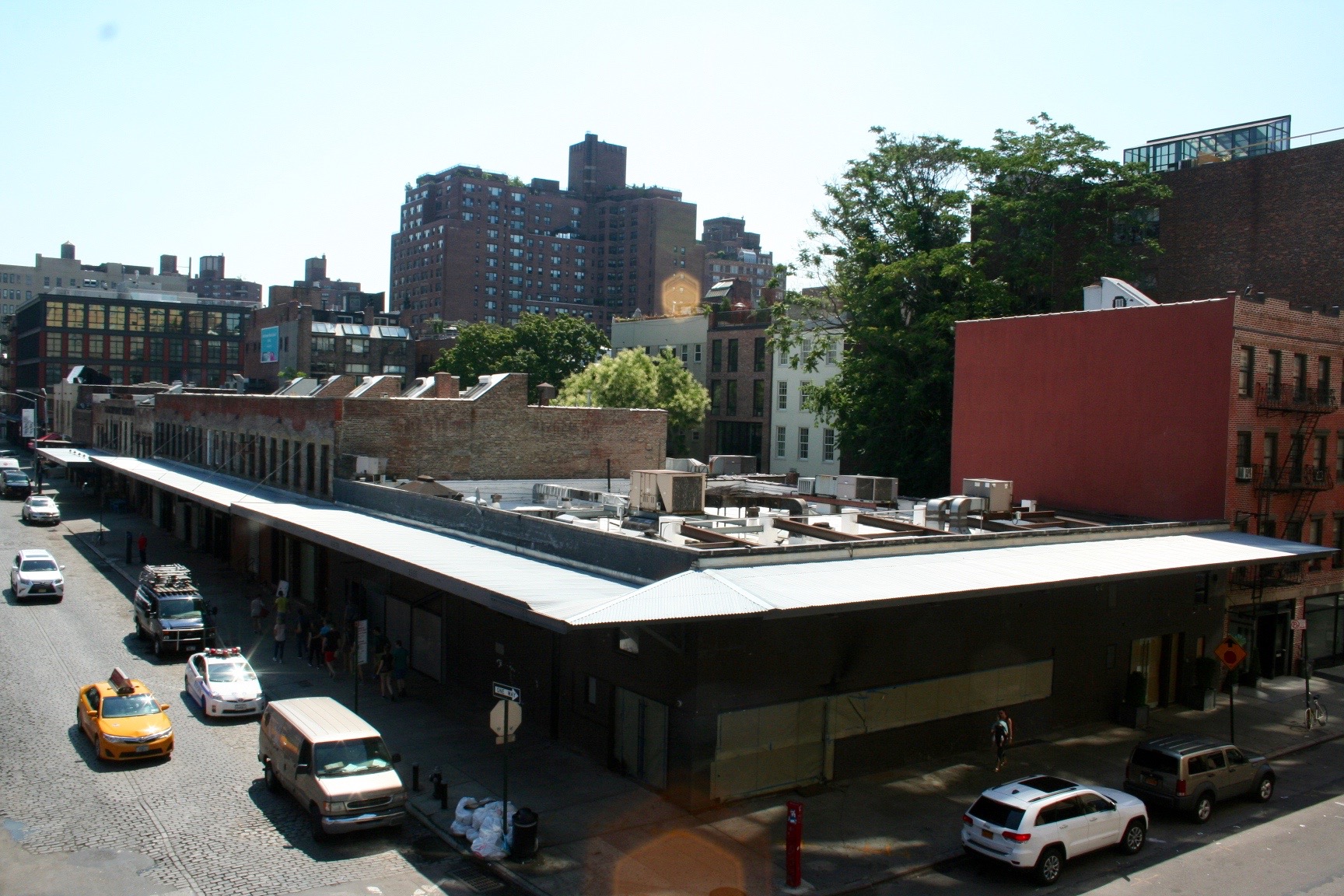
BY YANNIC RACK | Construction on a large-scale redevelopment in the landmarked Meatpacking District could start as soon as next spring, according to the developer who plans to demolish and replace some of the historic brick buildings on the south side of Gansevoort St.
Concerned residents living in and near the district packed a room above the Gansevoort Market food court on the evening of Tues., Aug. 18, to hear the developer’s proposal for a row of new buildings that will reach up to eight stories and replace some of the one- and two-story market buildings that currently line the block, between Greenwich and Washington Sts.
“I think Gansevoort St. has been a blight for the community,” Jared Epstein, vice president and principal at Aurora Capital Associates, told the meeting.
The remark, meant to illustrate that large portions of the buildings on the street currently sit empty or have housed nightclubs unpopular with the community, was met with outcries from the audience.
Most of the locals present were concerned, if not enraged, about the plans, which they fear would destroy the character of the neighborhood and even lower property values.
In addition, the buildings are all located within the Gansevoort Market Historic District, which was designated in 2003 after years of campaigning from community activists.

“This developer will have an enormous fight on their hands if they seek to move ahead with this proposal,” said Andrew Berman, executive director of the Greenwich Village Society for Historic Preservation.
“This is not why we fought for years to get the Meatpacking District landmarked,” he added.
“Frankly, I think the proposal is crazy and I can not imagine that anybody at the Landmarks Preservation Commission, who is charged with preserving the character of historic neighborhoods, would do anything but reject this proposal outright.”
Aurora is developing the project together with William Gottlieb Real Estate. The two companies are also currently building a “glass cube” addition atop 9-19 Ninth Ave, the former site of Keith McNally’s popular French bistro Pastis.
As The Villager reported two weeks ago, the plan for their latest project — situated right across the street from the southern end of the High Line and the new Whitney Museum of American Art — is split into three separate zoning lots.
“This is a real labor of love for us,” said Harry Kendall, one of the two architects from BKSK Architects who presented the proposal.
“I know you’re all here because you’re concerned, but we hope that this presentation will alleviate some of your concerns.”
He explained that the easternmost part of the site, the two-story building at 46-48 Gansevoort St. at the corner of Greenwich St., would be kept as is but “cleaned up” — meaning extraneous signage and piping would be removed, and the brick facade would be restored.
The building would also receive two marquees extending over the sidewalk.
“It’s quirky things like that we want to incorporate into the design,” Kendall noted.
The first lot also includes 50 Gansevoort St., a lower two-story building that currently houses The Griffin nightclub.
Todd Poisson, also of BKSK, said the existing building would be demolished and replaced with a three-story one instead, raising the height to about 45 feet, not counting an additional 10 feet of rooftop mechanicals.
Immediately west of 50 Gansevoort St., the second lot is currently occupied by the Gansevoort Market, an indoor food court that opened last year.
On Tuesday, Epstein revealed that Keith McNally’s Pastis restaurant would take over most of that space and is currently eyeing a reopening date in early 2017.
He later added that the market, whose lease will expire in time, will potentially reopen at a different location in the area.
The third lot, from 60-74 Gansevoort St., is split in two under the proposal: Numbers 60-68 would receive an additional three floors on top of their existing two stories, plus another fourth floor that would be set back 20 feet.
The one-story building at 70-74 Gansevoort St. would be demolished completely and replaced by a six-story building with a two-story setback, raising the total heights at the block’s western end to 78 and 111 feet, respectively.
While this is still lower than the old Manhattan Refrigerating Company building across the street — which was converted years ago into the West Coast Apartments — the sentiment during and after the meeting was unanimous.
“I was very disappointed. It’s grossly out of scale and completely lacks historical context,” said Zack Winestine, the co-chairperson of the Greenwich Village Community Task Force, who lives nearby on Horatio St.
“It looks like a short Madison Avenue,” agreed Elaine Young, a member of Community Board 2 who lives just south of the Meat Market.
“I think their history justifications are very shaky. They’re grasping for a reason, it doesn’t actually make sense,” she added, referring to the architects’ claim that the block’s existing buildings actually used to be higher than they presently are.
Vincent Inconiglios, who moved to the area in 1969 and is one of the few grandfathered residents actually living on Gansevoort St., did appreciate one aspect of the proposal.
“I like what they’ve done in terms of trying to tier the buildings,” he said. “I think the reality is that this is not the Meatpacking District any longer.”
Inconiglios still remembers when racks of meat would be a common sight on the block and there was “fat in the street.”
“It’s changed dramatically,” he said. “I’ve seen so much of it change and the concern of the people here, I think, is very real.”
Charles Portelli lives on Horatio St., whose backyards are adjacent to the Gansevoort St. buildings.
“Building a larger building that shadows and cuts off views suddenly lowers the value of other people’s property, so you’re going against zoning,” he said, echoing the concerns of many residents on his street who were present at the meeting.
“You’re blocking off the right to light,” he said. “You’re blocking off views.”
Portelli also said he would like to see the character of the stores on the street preserved, for example mentioning a carpentry shop that used to be there.
“There were actual tradespeople in the neighborhood,” he said. “Now it turned into pretty expensive shops, which the people who live in this area can’t actually afford.”
In addition to landmark protection, a restrictive declaration is in place for the buildings on Gansevoort St., prohibiting their use as residential apartments, hotels or office space.
Asked what kind of stores would occupy the street’s ground-floor spaces under their plan, Epstein named luxury retailers like Gucci, Louis Vuitton and Hermes.
The upper floors on the block could be used as small offices by the ground-floor retailers, which the restrictive declaration allows, or be leased to art galleries or even a fitness center like SoulCycle, he said. Offices not directly associated with the ground-floor retailers would not be allowed under current zoning.
Epstein noted that the developers originally wanted to use all the upper floors as general office space — without any restrictions — and claimed that Councilmember Corey Johnson’s office, as well as the City Planning Commission, were on board with lifting the restrictive declaration.
“Right now we’re comfortable building the buildings without an office use,” he said, quickly adding a disclaimer. “If we had the restrictive declaration lifted, it would be for offices.”
Brooke Schafran, a spokeswoman for Aurora, said the developers were not planning to appear before the Landmarks Preservation Commission until October, citing Oct. 27 as the earliest possible date.
“We want to make sure that people have had a chance to look at it and weigh in and be fully informed,” she told the meeting. “We do plan on having probably another meeting in September, or as many meetings as people would like us to have. And then obviously there will be a formal community board presentation before we go to Landmarks.”
Two weeks ago, a spokesperson for William Gottlieb Real Estate said the developers planned to start work on the project within the next six months. Epstein on Tuesday confirmed that the work could start as early as spring 2016 if L.P.C. gives the green light.
Construction would then take 18 months from groundbreaking to completion.
Asked whether there was any chance the project would go even higher than currently proposed, he shook his head.
“Absolutely not,” he said.

















